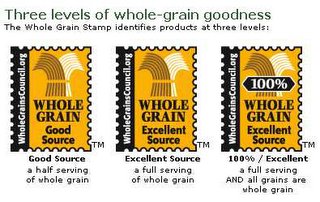 Consumers searching the grocery aisles for authentic whole grain foods now have a new "search tool" – the Whole Grain Stamp. Making it easy for shoppers to spot whole grain foods will help close the Whole Grains Gap and promote a goal long sought by nutrition and medical experts.
Consumers searching the grocery aisles for authentic whole grain foods now have a new "search tool" – the Whole Grain Stamp. Making it easy for shoppers to spot whole grain foods will help close the Whole Grains Gap and promote a goal long sought by nutrition and medical experts.With the Whole Grain Stamp, consumers won't need to read ingredients or count grams and ounces to meet the whole grain goals in the 2005 Dietary Guidelines. The Stamp makes it easy to get the recommended three servings a day of whole grains: Eating three whole grain food products labeled "Excellent Source" or "100%/Excellent" does the trick – or six products labeled "Good Source.
The 2005 Guidelines advise eating half or more of our grains as whole grains – at least three 16g servings per day. A "Good Source" contains at least 8 grams of whole grains per labeled serving, while an "Excellent" or "100% Excellent Source" contains at least 16 grams of whole grains per labeled serving.
Definition of Whole Grains
Whole grains or foods made from them contain all the essential parts and naturally-occurring nutrients of the entire grain seed. If the grain has been processed (e.g., cracked, crushed, rolled, extruded, lightly pearled and/or cooked), the food product should deliver approximately the same rich balance of nutrients that are found in the original grain seed.
Examples of generally accepted whole grain foods and flours are:
Amaranth, Barley (lightly pearled), Brown and Colored Rice, Buckwheat, Bulgur, Corn and Whole Cornmeal, Emmer, Farro, Grano (lightly pearled wheat), Kamut® grain, Millet, Oatmeal and Whole Oats, Popcorn, Quinoa, Sorghum, Spelt, Teff, Triticale, Whole Rye, Whole or Cracked Wheat, Wheat Berries, and Wild Rice.
Taken from:
The Whole Grains Council
A Consortium of Industry, Scientists, Chefs and
Oldways Preservation Trust committeed to
increasing consumption of Whole Grains for better health


No comments:
Post a Comment